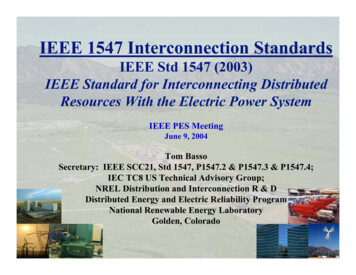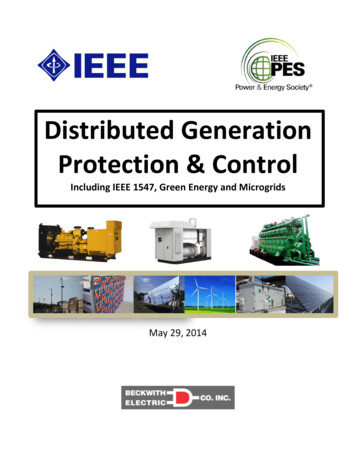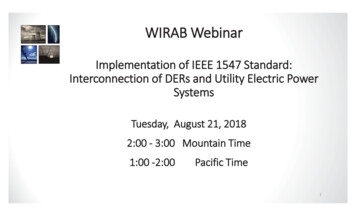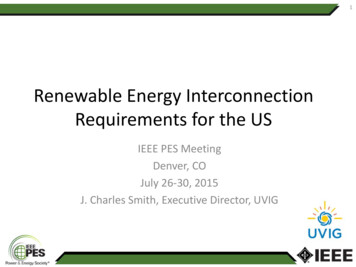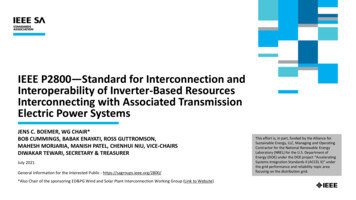
Transcription
IEEE P2800—Standard for Interconnection andInteroperability of Inverter-Based ResourcesInterconnecting with Associated TransmissionElectric Power SystemsJENS C. BOEMER, WG CHAIR*BOB CUMMINGS, BABAK ENAYATI, ROSS GUTTROMSON,MAHESH MORJARIA, MANISH PATEL, CHENHUI NIU, VICE-CHAIRSDIWAKAR TEWARI, SECRETARY & TREASURERJuly 2021General Information for the Interested Public - https://sagroups.ieee.org/2800/*Also Chair of the sponsoring ED&PG Wind and Solar Plant Interconnection Working Group (Link to Website)This effort is, in part, funded by the Alliance forSustainable Energy, LLC, Managing and OperatingContractor for the National Renewable EnergyLaboratory (NREL) for the U.S. Department ofEnergy (DOE) under the DOE project “AcceleratingSystems Integration Standards II (ACCEL II)” underthe grid performance and reliability topic areafocusing on the distribution grid.
Acknowledgements and disclaimersGeneral disclaimer:The views presented in this presentation are the personal views of the individuals presenting it and shall not be considered the officialposition of the IEEE Standards Association or any of its committees and shall not be considered to be, nor be relied upon as, a formal positionof IEEE, in accordance with IEEE Standards Association Standards Board Bylaws 5.2.1.6.Draft standard disclaimer:P2800 is an unapproved draft of a proposed IEEE Standard. As such, the document is subject to change, any draft requirementsand figures shown in this presentation may change.For those working group members whose effort on the standard was partially or fully supported by the U.S. DOE’s NationalRenewable Energy Laboratory, the following statement applies:This work was supported in part by the National Renewable Energy Laboratory, operated by Alliance for Sustainable Energy, LLC, for the U.S.Department of Energy (DOE) under Contract No. DE-AC36-08GO28308. Funding provided by U.S. Department of Energy Office of EnergyEfficiency and Renewable Energy Solar Energy Technologies Office and Wind Energy Technologies Office. The views expressed in the articledo not necessarily represent the views of the DOE or the U.S. Government.2
Anticipated Timeline, and What Comes Next?Jan 2019Dec 2020P2800WG Draftingin ividualproject*RelatedactivitiesIEEE 1547.1is publishedNERC IRPWGGuidelinesQ4/2021Submit toRevComQ1-Q2/2022202220232024PublicationWG Draftingin ParallelSubGroupsBalloting &PublicationKick-OffWG Draftingin 0Adoption PotentialP2800.2Adoption IEEE P2882*Project authorization request (PAR) approved by NesCom on May 21, 2021 web/app#viewpar/12623/9133); contact andy.hoke@nrel.gov and signup for P2882 Working Group and Task/Project on IEEE SA myProject at eb/app#interestsAs soon as IEEE P2800 has been successfully balloted,the drafting of conformance procedures will commence in projectslike IEEE P2800.1, P2800.x, and P2882.3
Next Deliverables, Milestones & MeetingsDeliverableMilestone: WG and Sponsor Approve WG Draft 5.1Mandatory Editorial Coordination (MEC) Draft 5.2Ballot Group FormationComment Resolution Group (CRG) FormationStakeholder WebinarsMilestone: SA Initial Ballot of Draft 6.0 (successful)Comment Resolution Group meets weeklyPublic Review closedCRG Comment Resolutions and Draft 6.1 CompletedWG Approval of Recirculation Draft (Draft 6.1)Recirculation 1 (successful)Recirculation 1 - Comment ResolutionCRG Comment Resolutions and Draft 6.2 CompletedRecirculation 2Recirculation 3Milestone: Submission to RevComMilestone: PublicationImportant DatesJanuary 2021February 1 – March 8, 2021February 1 – March 8, 2021, balanced outcome with 466 subject matter expertsFebruary 8 – March 8, 2021, received 38 self-nominationsWebinars for national and international stakeholders Objective was to raise awareness for the open ballot group formation Reviewed i) purpose and scope of standard and ii) key draft requirements Provided step-by-step instructions for how to join the ballot groupFebruary 2021: refer to https://sagroups.ieee.org/2800/resources/ for slide decks & recordingsMarch 10 – April 10, 2021 with 79% response rate ( 75% was required)84% approval rate ( 75% was required) 1,407 comments received (659 are “must be satisfied”)CRG resolved SA Initial Ballot commentsMay 9, 2021 (search for “2800” at https://publicreview.standards.ieee.org)June 9, 2021June 9, 2021June 10 – July 9, 2021, with 86% response rate ( 75% is required)89% approval rate ( 75% is required) 406 comments received (235 are “must be satisfied”)July – August/September 2021*July 21, 2021: CRG call, then SubGroup leads resolving SA Recirculation 1 comments, subsequent CRG calls TBDAugust/September 2021*September 2021* (14 days comment resolution)November 2021* (5 days comment resolution)Dec 11, 2021 or Feb / Mar / May 2022?*Q1 or Q2 of 2022*Next milestone* Tentative dates4
IEEE-SA Sponsor Ballot & Public Review IEEE SA Ballot Group invitation was sent to 2,500 subjectmatter experts within IEEE societies and their committees Formed a balanced ballot group with 466 balloters Initial ballot ended on April 10, 2021, draft was available to balloters onmyProject at b/app#myballots, 79% response rate ( 75% was required) Public review ended on May 9, 2021, search for “2800” athttps://publicreview.standards.ieee.org/ More information is available on the P2800 website athttps://sagroups.ieee.org/2800/members/ Important Milestones:Milestone:SA Initial Ballot closedRecirculation 1Recirculation 2Recirculation 3Milestone: Submission toRevComMilestone: Publication84% approval rate ( 75% was required)1,407 comments received (659 are “must be satisfied”)June 10 – July 9, 2021,89% approval rate ( 75% is required)406 comments received (235 are “must be satisfied”)September 2021*November 2021*Dec 11, 2021 or Feb / Mar / May 2022?*Q1 or Q2 of 2022** Tentative dates466 BallotersTOP 10 Balloter Groups (n 466)1. Consulting (25%)2. General Interest (14%)3. Other (11%)4. Producer – System / Manufacturer (8%)5. Research (6%)6. Service Provider – Design Services (5%)7. Producer – Component (5%)8. User – Industrial (5%)9. Academic – Researcher (4%)10. Government (3%)Consensus 75% Quorum 75% Approval WG Chair’s goal is 90%!
Standards Development LifecycleThis presentation provides an overview of Stage 4 of the standards developmentlifecycle –Balloting the Standard6
Public Review Process OverviewA 60 day Public Review period begins automatically with the opening of the SA BallotThe IEEE SA Public Review process provides an opportunity for any interested party to submit comments on anyeligible initial ballot draft, and obtain responses from the IEEE Working Group.All comments received from the Public Review period shall be considered and responded to. Public Reviewcomments do not have votes associated with them. Consensus is not based on Public Review comments Working Group/Comment Resolution Group will identify in their response if they have determined that theywill make a change in the draft If responses identify a change to the draft, the Public Review commenter can request a revised draft Each public review commenter receives only their responses As normally required, changes to the draft must be recirculated in a SA Ballot recirculation All Public Review comments and responses shall be submitted to RevCom7
IEEE SA Ballot consensus: Response & approval rateIEEE SA Ballot Consensus is achieved when: At least 75% of the ballot group voted (Response rate) The number of Approve votes is 75% or more of the total Approve and Do Not Approve (with Comments) votes.(Approval Rate) Fewer than 30% of the ballot group voted AbstainResponse Rate: If the response rate is not met: The ballot can be extended by the Program Manager (PM) WG Officers and PM can work together to reach out to those that have not responded The response rate must be met in order to continue with the balloting process.Approval Rate: If the approval rate is not met, the entire draft is open for comments on the next ballot (recirculation). not the case for P2800! During a recirculation ballot, SA balloting group members shall have an opportunity to cast votes or change their previouslycast votes.8
Balloting Flow chartYesYesYesPlease see section 6.10 of the myProject user guide for steps on how to Ballot9
SA Ballot Next Steps - Recirculation OverviewWhen is a recirculation ballot required? All unresolved Do Not Approve votes with comments shall be recirculated to the Standards Associationballoting group. All substantive changes made since the last ballot of the proposed standard shall be identified andrecirculated to the Standards Association balloting group. If there are significant changes made to the draftyou may consider opening: The entire draft for comments on the next ballot recirculationThe recirculation for a longer period of timeRecirculation ballot(s): Minimum of 10 days During a recirculation ballot, SA balloting group members shall have an opportunity to cast votes or changetheir previously cast votes Once the proposed standard has achieved 75% approval, comments in recirculation ballot(s) shall be basedon: this is the case for P2800! Only on the changed portions of the draft Portions affected by the changes Portions subject to unresolved comments associated with Do Not Approve votes.10
SA Ballot – Comment Resolution Guidelines The Comment Resolution Group will review and consider all comments that are received by the close of theballot. This includes comments received outside of the myProject system and mandatory coordinationcomments. Evidence of Consideration Comments that advocate changes in the proposed standard, whether technical or editorial, may be accepted,revised, or rejected. Until the proposed standard has achieved 75% approval, comments can be based on any portion of the proposedstandard Comments not based on the proposed standard may be rejected and deemed out-of-scope of the standardsballoting process by the Standards Committee.Comments received by the WG after the close of the ballot Shall be acknowledged and may be considered The Standards Committee shall acknowledge the receipt of these late comments Take action as the Standards Committee deems appropriate. For more information, see the IEEE SASB Operations Manual Clause 5.4.3.3 -Comments in the ballot11
Additional ResourcesThe SA Balloting g-standard/balloting.htmlRevCom Ballot and Comment Resolution Process elines.pdfRevCom Comment Resolution Preparation nt Resolution Preparation Guidelines.pdfIEEE SA Standards Working Group Chair Fundamentals Course, Module 10 “Balloting Your Standard”12
Summary of IEEE P2800 Draft Standard The draft standard harmonizes InterconnectionRequirements for Large Solar, Wind and Storage Plants It is a consensus-based draft developed by over 175Working Group participants from utilities, systemoperators, transmission planners, & OEMs over 2 years You can further influence the draft standard by1) reviewing resolutions of your comments and by voting in the 2ndrecirculation, expected to begin in August/September 20212) supporting adoption of the standardMore Info at https://sagroups.ieee.org/2800/13
IEEE P2800 Objective: Complementing North American Reliability StandardsTest & Verification &Model ValidationNARUC / State PUCs?FERC / ution(for DER) FERC Orders NERC Reliability Standards& Guidelines Not availableIEEEP2800 IEEE Std 1547-2018 NERC compliancemonitoring &enforcement Not available IEEE 1547.1-2020 Ul 1741 (SB) IEEE ICAPIEEEP2800.1and/or .x When adopted by the appropriate authority (e.g., TransmissionOwners, NERC, FERC), IEEE standards become mandatoryDER: DistributedEnergy Resources14
Approximately 300 Interested Parties and 175 WG MembersBroad Collaboration & pED&PGCom(Sponsor)EM Com(Joint Sponsor)PSRC Com(P2800 Joint Sponsor,P2800.1 Liaison)PSDP(Liaison)T&DCom(Liaison)IECWind and Solar PPInterc. & DesignSubComRE Machines andSystemsSubComC - SystemProtectionSubComPower System StabilityControls SubComDistribution SubComAMPS/VPSMGCSfor P2882Wind and Solar PlantInterc.WGWind and Solar PlantInterc.WG (Mirror)C.24 (Modeling) & C.32(Impact of IBR)WGsWG on Dyn. Perf. ofRESDistributed ResourcesIntegration WGSubstationCommitteeNERC IRPWG (Liaison)Wind and Solar PowerCoordinating Com(Liaison)SCC21(Liaison)Others?P2800 - Individual(performance)P2800.1 - Entity(test & verif.)Project Sub-Working GroupsLiaisons IEEE/PES/EDPG Main Sponsor IEEE/PES/EMC & PSRC Joint Sponsors HVDC-VSC Subject Matter Experts 99%Approval IEEE/PES/Substations Committee SMEs IEEE/PES/Analytic Methods for Power Systems(AMPS) SMEs NERC Inverter-Based Resources Performance WGSMEs15
IEEE P2800 Leadership TeamRoleNameAffiliationStakeholder GroupLiaisonChairJens C. BoemerEPRI, NRELAcademic/ResearchEDP&G, SCC21Vice-ChairBob CummingsNERCRegulatory and Governmental BodiesNERC IRPTFVice-ChairMahesh MorjariaREPlantSolutions, FirstSolarUsers, IndustrialNERC IRPTFVice-ChairBabak EnayatiNationalGridStakeholders represented inIEEE Power & Energy SocietyT&D, SCC21,PES GovBrdVice-ChairRoss GuttromsonSANDIA National LabAcademic/ResearchDOEVice-ChairChenhui NiuState Grid Corporation of ChinaStakeholders represented in IEEE P2800.1Working GroupIEEE P2800.1,IEC SC8AVice-ChairManish PatelSouthern CompanyUtility, TransmissionPSRC, IRPTFSecretary &TreasurerDiwakar TewariLeidosService Provider/ ConsultingEDP&GPast Vice-ChairKevin CollinsFirstSolarUsers, IndustrialNERC IRPTFPast SecretaryWes BakerEPRIAcademic/ResearchElectric Machinery16
The Type of Involvement Matters Identify experts in your organization tojoin the IEEE P2800 Working Group andone or several of its 11 sub-groups. Provide experts with time to attendmeetings and conference calls and tocontribute draft language. Encourage experts to actively engage inmeetings and conference calls, to notremain silent, and to speak up.P2800 Leadership Call for Active Involvement of TransmissionPlanning & OpsEntities, January2020(on iMeet here) IBR OEMs andRenewable PlantDevelopers,February 2020(on iMeet here)17
Status Quo -- Solar, Wind & Storage Interconnection Requirements Diverse & different requirements acrossvarious jurisdictions requires more effort and time to address Inverter-based resources (IBR) are differentfrom synchronous generators higher (and sometimes lower) capability Requirements may not be balancedSource: https://www.natf.net/ some too stringent & not taking advantage of newcapability18
IEEE Standards Classification and Consensus BuildingIEEE1547.1IEEE 1547Standardsdocumentsspecifying mandatoryrequirements (shall)IEEEP2800Recommended Practicesdocuments in which procedures andpositions preferred by the IEEE arepresented uments that furnish information – e.g., provide alternativeapproaches for good practice, suggestions stated but no clear-cutrecommendations are made (may)IEEEP2800.xIEEEP2800.119
What to expect from IEEE P2800? Provides Value– widely-accepted, unified technical minimum requirements for IBR– simplification and speed-up of technical interconnection negotiations– flexibility for IBR plant developers not an equipment design standard Specifies– performance and functional capabilities and not utilization & services– functional default settings and ranges of available settings– performance monitoring and model validation– type of tests, plant-level evaluations, and other verifications means, butnot detailed procedures ( IEEE P2800.1 and/or P2800.x) Scope– Limited to all transmission and sub-transmission connected, large-scalewind, solar, energy storage and HVDC-VSC20
Scope and Language of P2800 Requirements3. Informative2. Standard Appendix(“may”)1(“should”)11. Standard(“shall”, “may”)1 ifavailable,refer toexisting IEEEdocumentsImportant Terms point of connection (POC) IBR unit terminalsRPA for a subset of requirements:POC: point of connectionfeeder(s) point of measurement (POM) IBR plant point of interconnection (POI) interconnection system IBR tie line transmission system (TS) Transmission Sub-transmission supplemental IBR device Compensation Plant controller Etc.POCIBR unit,e.g., stringinverterIBR unit,e.g., stringinverterIBR unit,e.g., stringinvertersupplementalIBR device,e.g., stringcontrollercollectorbussupplementalIBR device,e.g., power plantcontroller(EITHER)Default RPA: point ofmeasurement (POM)one alternate RPA: point ofinterconnection (POI)interconnectionsystemIBR unit,e.g., invertertransmissionsystem (TS)POCIBR tie linemain IBRtransformer(s)LegendsupplementalIBR device,e.g., compensationsupplementalIBR device,e.g., compensationcollector systemIBR plant1two or more of wind, solar, and/or energy storage systemshybrid IBR plant2(hybrid) IBR plant other electric generating units and equipment,e.g., synchronous condensers, synchronous generators, compensationhybrid plant31: inverter-based resource (IBR):any parts that are within the scope of thisstandard, including IBR plant, IBR units,supplemental IBR devices, feeders, collectorbus, main IBR transformer, etc.2: hybrid IBR plant: IBR with various resourceslike wind, solar, and/or energy storage systems3: hybrid plant: only the IBR are within thescope of this standard4: plant controller as supplemental IBRdevice: control IBR units, other supplementalIBR devices, and IBR plant equipment like tapchangers21
Scope and Language of P2800 RequirementsAC-DC systemcollectorsystemtransmission system(TS)collectorsystempoint of connection(PoC)IBR plantThese would be the POMs of isolated AC-connected IBRs.1Default RPA: pointof measurement (POM)DC Line2 IsolatedIBR1,2DC-AC VSCConvertingStation2Includes IBR units like type IV wind turbine generatorsIBR tie lineOne alternate RPA: point ofinterconnection (POI)2 May serve as a supplemental IBR device that is necessary for the IBR plant with HVDC-VSCto meet the requirements of this standard at the RPAIn ScopeOut of Scope “Shall” requirements for isolated IBR connected via (no “shall” requirements, “may” at discretion of TS owner)dedicated HVDC-VSC link Isolated non-IBR connected via dedicated HVDC-VSC link Manitoba Hydro: Pole 3 at Dorsey “May” requirements for non-IBR resourcesconnected via dedicated HVDC-VSC link HVDC-VSC that connect two points in a synchronous area Any interconnections involving HVDC-LLC22
Scope and Language of P2800 RequirementsScope ofIEEE 2800reference pointof applicability (RPA)IBR planthybrid planthybrid IBR plantsyn. mixed IBR planta single IBR generatingresource or energy storagesystemmultiple IBR and non-IBRresources operated as oneby TS operatormultiple IBR operated as oneinverter-basedresourcesupplemental IBRdevice(s)generating resource(s)in scopein scopein scopegenerating resource(s)wind, solar, etc.in scopeenergy storage system(s)in scopecommon equipmentcapacitor banks, plantcontroller, protection, etc.wind, solar, etc.energy storagesystem(s)in scopein scopeemerging equipmentsynchronous condenser(s),etc.in scopeLegendco-located plantmultiple resources operatedseparately by TS ource(s)generation and/or storagegeneration and/or storagein scopein )synchronous machine, etc.synchronous machine, etc.out of scopeout of scopein scopein scopeunit & plant levelplant levelout of scope23
Examples for Inverter-Bases Resources (IBR) PlantsinverterDCPVPlantACin ePlantESSbidirectionalconverterRPAPOITSDefault Reference Point ofApplicability (RPA) isPoint of Measurement (POM)POI: Point of InterconnectionTS: Transmission System
Example hybrid IBR plant, ac-coupledin scopeinverterDCACRPAPVPOITSHybridPlantDefault Reference Point ofApplicability (RPA) isPoint of Measurement (POM)ACWTGsDCESSbidirectionalconverterPOI: Point of InterconnectionTS: Transmission System
Example hybrid plant: operated as a single resourcein scopenon-IBRRPAACconventionalgenerator or nonIBR ESSACRPAPOITSACIBR plant RPADefault Reference Point ofApplicability (RPA) isPoint of Measurement (POM)WTGsDCESSbidirectionalconverterhybrid IBR plantPOI: Point of InterconnectionTS: Transmission System
IEEE P2800 Technical Minimum Capability RequirementsTS ownercan requireadditionalcapabilityCapabilityRequired in eControlsPrioritizationQ for voltagecontrol atzero rolresponsesApplicabilityto DiverseIBR PlantsReactivePower– alanceRapid ity nBalancedCurrentInjectionVoltage RidethroughModeling &Validation,MeasurementData, andPerformanceMonitoringProcess andcriteria formodelvalidationHigh toringPlant-levelEvaluation &ModelingCommissioningTestsFrequency &Phase-jumpRide-throughCoordinationOf ProtectionTests andverificationrequirementsValidatedModelsType tests EPRIUtilization of these capabilities is outside the purview of P280027
Comparison of P2800 Initial Ballot (Draft 6.1) with IEEE 1547-2018Legend:Function SetGeneralMonitoring,Control, X Prohibited, Allowed by Mutual Agreement, ‡ Capability Required,(‡) Procedural Step Required as specified, Test and Verification DefinedAdvanced Functions CapabilityAdjustability in Ranges of Allowable SettingsPrioritization of FunctionsRamp Rate ControlCommunication InterfaceDisable Permit Service(Remote Shut-Off, Remote Disconnect/Reconnect)Limit Active PowerMonitor Key DER DataRemote ConfigurabilityFunction SetIEEE ‡‡‡Set Active Power‡Scheduling Power Values and Models Constant Power FactorVoltage-Reactive Power (Volt-Var)Autonomously Adjustable Voltage ReferenceCapability at zero active power (“VArs at night”)Active Power-Reactive Power (Watt-Var)Constant Reactive PowerVoltage-Active Power (Volt-Watt)Dynamic Voltage Support during VRTUnbalanced Dynamic Voltage Support during VRT‡‡‡Protection &Power Quality‡‡‡‡‡‡ Bulk SystemReliability&FrequencySupport‡‡‡Test, Verification,Modeling &MeasurementsAdvanced Functions CapabilityFrequency Ride-Through (FRT)Rate-of-Change-of-Frequency Ride-ThroughVoltage Ride-Through (VRT)Transient Overvoltage Ride-ThroughConsecutive Voltage Dip Ride-ThroughVoltage Phase Angle Jump Ride-ThroughFrequency-WattFast Frequency Response / Inertial ResponseReturn to Service (Enter Service)Black StartAbnormal Frequency TripAbnormal Voltage TripUnintentional Islanding Detection and TripLimitation of DC Current InjectionLimitation of Voltage FluctuationsLimitation of Current DistortionLimitation of Voltage DistortionLimitation of (Transient) OvervoltageProvision of Verified ModelsCollection of Measurement DataType TestsProduction TestsPlant-Level Design EvaluationCommissioning TestsModel ValidationPerformance MonitoringPeriodic TestsPeriodic VerificationIEEE 15472018‡‡‡‡‡‡‡ ‡ )(‡)IEEEP2800‡‡‡‡‡‡‡‡‡ ‡‡ ‡(‡)(‡)(‡)(‡)(‡)(‡)(‡)(‡)(‡)28
Clause 12 (Test and Verification) FrameworkWhere’s thereference point ofapplicability (RPA)?What’s thto VerifiorcationPoCRideThroughValidatedUnit Model(s)Type testsRequired path toverificationCategory of test andverification ioningmodel validationPostcommissioningmonitoringPeriodictest est orverification(IBR units) (Design & ning Test29
Clause 12 (Test and Verification) FrameworkPotential BenefitsPotential Challenges Raising the bar of existing plant-level capability and Does not replace engineering judgement andperformance verification procedures.experience. Reducing the uncertainty of plant-levelperformance.–The smaller the grid, the higher the impact of uncertainty. Improve the validity and accuracy of plant-levelmodels and their parameterization. Could create a false perception of modelingaccuracy. Finding the right balance between standardizationand flexibility.Way forward IEEE Individual ProjectsP2800.2 (Recommended Practice) andP2882 (Guide) IEEE P2800.1 Entity Project30
Related IEEE Standard Association activitiesP2800.2: Recommended Practice for Test and VerificationProcedures for Inverter-based Resources (IBRs)Interconnecting with Bulk Power SystemsP2882: Guide for Validation of Software Models ofRenewable and Conventional Generators for Power SystemStudies Type: recommended practice, individual project Type: guide, individual project Sponsor(s): IEEE/PES/EDPG EMC PSRC AMPS Sponsor(s): IEEE/PES/AMPS EMC EDPG Tentative timeline: June 2023 (initial ballot), Dec 2023(RevCom approval) Tentative timeline: Dec 2021 (initial ballot), Dec 2022(RevCom approval) Scope: recommends leading practices for test andverification procedures that should be used to confirmplant-level conformance of IBRs interconnecting withBPSs under IEEE Std 2800. Scope: guidelines for the validation of software modelsfor renewable and conventional generators used forpower system studies. complements the IEEE 2800 test and verification framework with specificationsfor the equipment, conditions, tests, modeling methods, and other verificationproceduresmay specify design and as-built evaluations procedures for verification ofplant-level capabilities and performancemay also specify verification procedures for IBR plant-level generic modelsapplied for different time frames including S/C models, RMS models, and EMTmodels ‘validation’ is a procedure and set of acceptance criteria . to confirm thatthe models perform well numerically and provide the intended response(s).does not cover validation of generator software models against fieldmeasurements and other types of site or factory tests31
Logistics32
IEEE P2800Working GroupWebsite (public)https://sagroups.ieee.org/2800/Mailing Liststds-p2800@listserv.ieee.orgCollaborative Workspace for WG -p/IEEE P2800 SubGroupLead ( Officer)Mailing ListI. Overall DocumentJens C Boemerstds-p2800-sg1@listserv.ieee.orgII. General RequirementsBob Cummingsstds-p2800-sg2@listserv.ieee.orgIII. Active Power – Frequency ControlMahesh Morjariastds-p2800-sg3@listserv.ieee.orgIV. Reactive Power – Voltage ControlMahesh Morjariastds-p2800-sg4@listserv.ieee.orgV. Low Short-Circuit PowerRoss Guttromsonstds-p2800-sg5@listserv.ieee.orgVI. Power QualityRoss Guttromsonstds-p2800-sg6@listserv.ieee.orgVII. Ride-Through Capability RequirementsBob Cummingsstds-p2800-sg7@listserv.ieee.orgVIII. Ride-Through Performance RequirementsManish Patelstds-p2800-sg8@listserv.ieee.orgIX. IBR ProtectionBabak Enayatistds-p2800-sg9@listserv.ieee.orgX. Modeling & Validation, Measurement Data, and PerformanceMonitoringManish Patelstds-p2800-sg10@listserv.ieee.orgXI. Tests and verification requirementsChenhui Niustds-p2800-sg11@listserv.ieee.org Mailing lists are open to all Interested Parties (“Participants”), not only to WG Members.33
P2800 Joint Sponsorship & CoordinationED&PGCom(Sponsor)EM Com(Joint Sponsor)PSRC Com(P2800 Joint Sponsor,P2800.1 Liaison)PSDP(Liaison)T&DCom(Liaison)IECWind and Solar PPInterc. & DesignSubComRE Machines andSystemsSubComC - SystemProtectionSubComPower System StabilityControls SubComDistribution SubComAMPS/VPSMGCSfor P2882Wind and Solar PlantInterc.WGWind and Solar PlantInterc.WG (Mirror)C.24 (Modeling) & C.32(Impact of IBR)WGsWG on Dyn. Perf. ofRESDistributed ResourcesIntegration WGSubstationCommitteeNERC IRPWG (Liaison)Wind and Solar PowerCoordinating ForceJointWorkingGroupP2800 - Individual(performance)P2800.1 - Entity(test & verif.)Project Sub-Working GroupsLiaisons34
Instructions for Mailing ListsIEEE P2800 Working Group and Sub-WGs Listservs – Public Reflector ----------------------------------------NOTE: The IEEE P2800 Working Group public reflector is provided for the benefit of moving the work of the Working Group forward. Use of thisreflectors is subject to the IEEE E-mail Acceptable Use Practices.Subscribing to the ---------------------------------------To subscribe to the P2800 listservs, send an e-mail to listserv@listserv.ieee.org with the following command in the body of the e-mail:Subscribe stds-p2800 lastname, firstnameEnd replace red part with the name of any of the Sub-WGs mailing listsSubscribe Note 1: Use of the e-mail subscribe instruction requires that you supply your Last Name followed by your First Name and will subscribe the e-mailaddress from which the e-mail is sourced from. The e-mail subscribe instruction does not support an e-mail address field, if you try to use an e-mail address in theName fields it will be rejected. If you wish to subscribe an e-mail addr
IEEE-SA Sponsor Ballot & Public Review IEEE SA Ballot Group invitation was sent to 2,500 subject matter experts within IEEE societies and their committees Formed a . balanced ballot group . with . 466 balloters Initial ballot . ended on April 10, 2021, draft was available to ba

